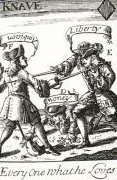
Abstract
The debate about the Peace of Utrecht was the first full-fledged manifestation in eighteenth-century England of an emerging »public political culture« - a major cultural invention which in the long run also set an example for the rest of the world. The present monograph is the first book-length attempt at a detailed account of the public controversy about the ending of the War of the Spanish Succession from 1710 to 1713, with special emphasis on its rhetorical features. In inquires into the linguistic translation of the will to shape politics by appealing to an ever-widening audience and deals with the strategies employed by Government and Opposition in their wooing of public opinion. The analysis focuses on the dynamics of the polemical interaction in the turning-point debate between the autumn of 1711 and the spring of 1712. In its attempt to shed light on the process of how the political arena was occupied verbally, the book provides the first systematic assessment of the specific function of the various forms of political writing in the dessimination of propaganda, drawing on a numerous textual examples among the whole gamut of genres participating in the public debate. Particular attention is further paid to the language of politics with special reference to the antagonism between Whigs and Tories. This thoroughly researched interdisciplinary study is of great interest to historians and literary historians alike and provides fresh insights into the sophisticated interaction of print and politics so brilliantly inaugurated in the reign of Queen Anne and characteristic of modern public life right up to our times.
Preliminary Methodological Considerations
1. The War of the Spanish Succession as Reflected in Public Discussion until the Summer of 1710
1. End of August until mid-October 1711
1. The Pamphlet
2. The Political Essay
3. The Newspaper
1. Whig Rhetoric
2. Tory Rhetoric
1. Social Background and Denominational Allegiance of Authors; Genres and Party-Political Orientation
The Development of a 'Public Political Culture' in England after the Glorious Revolution
The Concept of Public Opinion
2. The Temporal Structure of the Public Debate on how to End the War
2. From the Publication of the Preliminaries to the Appearance of The Conduct of the Allies
3. The Public Dispute between December 1711 and April 1712
4. The Polemical Impact of The Conduct of the Allies
The Rhetorical Profile of the Main Political Periodicals
4. The Broadside
5. The Sermon
2. Aspects of a Genre (the Political Essay) and its Readership